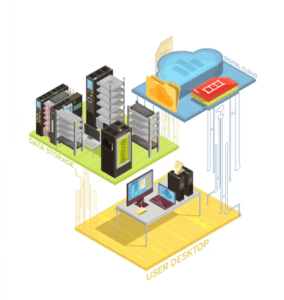Developing Cloud-Native Applications: Key Principles and Techniques
The tech world is changing faster than ever, and businesses need applications that can adapt to these changes seamlessly. Cloud-native application development allows developers to create services for the cloud. Cloud-based application development enables developers to design applications that solve modern digital problems and provide better scalability and flexibility options.
In this article, we will explore key principles and techniques behind developing agile and efficient cloud-native applications. From containerization to microservices, from DevOps practices to Infrastructure as Code, we will cover it all. By the end, we will delve into Nife, a cloud platform that embraces the ethos of cloud-native applications.
Key Principles of Cloud-Native Application Development#

Cloud-based application development is transforming how applications are built and deployed in the cloud. Developers can now unlock new potentials of the cloud by creating more resilient, scalable, and efficient applications. In this section, we will explore the key principles of cloud-native application deployment.
Containerization#
One of the most crucial principles of cloud-based application development is containerization. It involves deploying applications in an isolated environment to ensure consistent behavior across different environments. The container encapsulates your application along with its dependencies, ensuring it operates uniformly. Containers are lightweight, fast, and highly efficient.
Docker and Kubernetes are pivotal for containerization. Docker creates and manages containers, keeping your application and all its dependencies in a container image. This image contains everything your application needs to run, ensuring consistent behavior across platforms regardless of the underlying infrastructure.
Kubernetes, on the other hand, facilitates scaling, load balancing, and automated management of container workloads, ensuring your application functions seamlessly so you can focus on development.
Microservices Architecture#

Another vital principle of cloud-native application development is adopting microservices architecture. In this architecture, complex applications are broken down into smaller, manageable services that can be developed, deployed, and scaled independently.
Microservices architecture enhances fault isolation. Each service is responsible for a specific task, so issues in one service don't affect others, unlike in a monolithic architecture. Moreover, this architecture supports scalability, as resources can be allocated to specific services in response to increased demand.
DevOps Practices#
Cloud-based application development requires collaboration between different services, achievable through DevOps practices. DevOps practices eliminate silos between development and operations teams, fostering collaboration, continuous integration, and deployment.
Continuous Integration (CI) ensures that developers' changes are saved in the code repository. Continuous Deployment (CD) automates the release process, enabling frequent updates and new feature rollouts.
Infrastructure as Code (IaC) is another critical aspect of DevOps practices. IaC allows for automation, versioning, and consistency, reducing manual errors and streamlining processes.
Techniques for Developing Cloud-Native Applications#
Developing cloud-native applications requires leveraging specific techniques to fully utilize cloud capabilities. Here are some techniques to develop robust cloud-native applications:
Cloud-Native Design Patterns#
Design patterns are essential for scalability, fault tolerance, and efficiency in cloud-native applications. They address common problems developers face, making their implementation crucial. Here are some key patterns:
Circuit Breaker Pattern: Manages dependencies between services, preventing potential failures and providing a fallback option when a service is unavailable. It's especially useful for integrating external services.
Auto-Scaling Pattern: Facilitates load balancing by allowing applications to automatically adjust resources based on demand. This pattern ensures applications can handle load by scaling up or down as needed.
Security#

Security is crucial for cloud-native applications. Cloud application development services must adhere to best security practices to protect data. Here are some essential security practices:
Secure Authentication: Implement multi-factor authentication to ensure that only authorized personnel have access. This can be achieved through fingerprints or one-time password-generating apps.
Data Encryption: Protect sensitive data by using encryption for both data at rest and in transit, safeguarding your data in the cloud and across networks.
Regular Security Audits: Conduct regular security audits to identify and address vulnerabilities promptly.
Continuous Monitoring and Observability#
Monitoring and observability are vital for detecting issues and weaknesses in cloud-native application development. Here are some techniques:
Metric Collection and Analysis: Provides valuable insights into application performance. By tracking metrics like memory consumption and CPU usage, developers can ensure optimal performance.
Error Tracking: Utilize cloud monitoring tools to track errors, helping to identify recurring issues and enhance the stability and reliability of your cloud applications.
Centralized Logging: Centralized logging allows for identifying patterns and analyzing data from various components in one place.
Nife: Empowering Cloud-Native Application Development#

Nife is a cutting-edge cloud platform that empowers developers in cloud-native application development. Nife simplifies containerization and orchestration, leveraging Kubernetes for deployment, scaling, and container management, ensuring optimal performance. With Nife, developers can focus on application development without worrying about the underlying infrastructure.
Nife streamlines CI/CD by automating development, testing, and deployment processes. It provides detailed information about resource consumption, enabling informed decision-making. Nife's robust security features prioritize data protection through encrypted communication, strict access controls, and compliance management.
Visit Nife to learn more and get started on your Cloud Native journey.
Conclusion#
To leverage the full potential of the cloud, developing cloud-native applications is crucial. By adhering to the principles of containerization, microservices, and DevOps, developers can build scalable, resilient, and efficient applications. Implementing techniques like monitoring, security, and cloud-native design patterns is essential for the smooth operation and performance of these applications.
Ultimately, using a platform like Nife can significantly enhance your cloud-native application development process.


